On 25 & 26 April, edcom members met at University of the Arts London for their annual Spring meeting to discuss the industry’s burning topics, share what’s happening at their home universities, network, elect the new presidents, board and research committee and exchange ideas.
The first day of the conference focused on the topic of Social Purpose and Sustainability.
New President Address:
Arnoud Versluis, Breda University of Applied Sciences and Kirstie Riedl, Fachochschule Wiener Neustadt, were elected unanimously by the edcom members to take on the role as edcom Presidents for a 4-year term from 2024-2028. Prior to the meeting, they shared their presidential candidacy letter entitled ‘Touch and be touched’, which can be viewed here. As addressed in their letter, touch and be touched is the approach to go; with a focus on the clusters of education, research, industry, network, and alumni. You can find their presentation here.
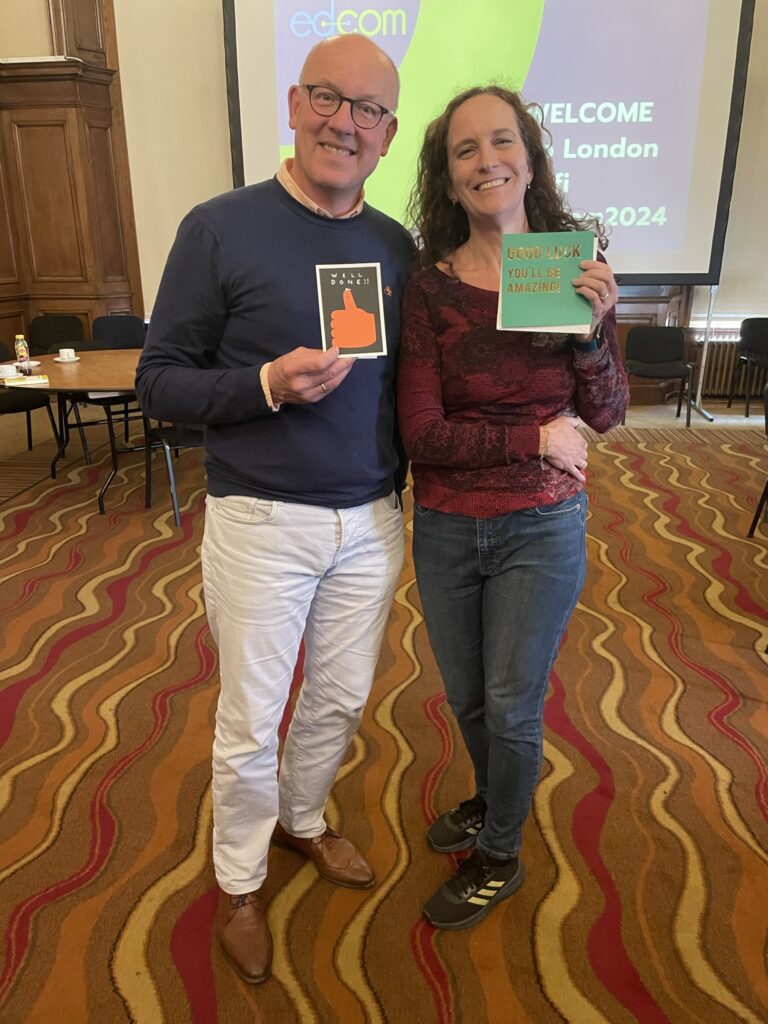

New Board and Research Committee
The board and research committee candidates were also elected unanimously by members on the day and on an online platform for those who couldn’t make it in person. The new board now comprises of six academics and two industry practitioners: Betty Tsakarstou, Panteoin University of Social and Political Sciences, Dagmar Weberova, Tomas Bata University in Zlín, Joep Peeter, Fontys Hogeschool Tilburg, Melanie Gray, University of Roehampton, Natia Kaladze, University of Georgia, Steve Spence, University of the Arts London, Richard Robinson and Micky Denehy, Denehy Connection. The new research committee which will be led by Paul Springer, University of the Arts London includes; Melanie Gray, University of Roehampton, Leli Bibilashi, University of Georgia, Sieglinde Martin, FHWien der WKW University of Applied Sciences Austria, Luc van Dijk-Wijmenga, HU University of Applied Sciences and Mădălina Moraru, University of Bucharest.
In the Spotlight: Members Presentations
Melanie Gray from the University of Roehampton presented a thought piece titled ‘Generative AI and its impact on Creative Education: Thought Piece’. She discussed how educators in creative disciplines are embracing a transformative role as they incorporate AI into their teaching methodologies and evaluation processes. She noted that in education, the emergence of AI must be faced by engaging in discussions and debates, understanding the biases that go with AI systems, and collaboratively developing effective methods to incorporate it in teaching practices. Read the rest of her thought-piece presentation here.
Dagmar Weberova and Radomila Soukalova from Tomas Bata University in Zlín presented on a project based on promoting foot health prevention in children through the use of an interactive educational storybook, a memory game, video resources and a mobile game. To read more about this project you can find the presentation here.
Jonathan Hardy, University of the Arts London and Iain Mc Rury, University of Stirling presented on Branded Content Project. Jonathan described the project’s aims and scope, and presented issues and explanatory frameworks that might be helpful in advertising education. This included the argument of a shift from a core triad (marketers, agencies, media) to an emerging sextet (marketers+, agencies+, media+, content creators, platforms, adtec). He gave an overview of changes in the regulation of branded content, including native advertising and influencer marketing, and set out the project’s initial mapping of ‘problems’ in marketing practice and governance, and possible mitigations, finishing with suggestions for class discussion. Iain developed this further, sharing findings from BCG project research interviewing practitioners on their relationship to governance, and placing the effort to manage the disruptions of innovations in advertising in a centuries-old historical context. He discussed ideas and resources for teaching including inviting students to review TikTok promotions and influencer marketing disclosure. Find the presentation here.

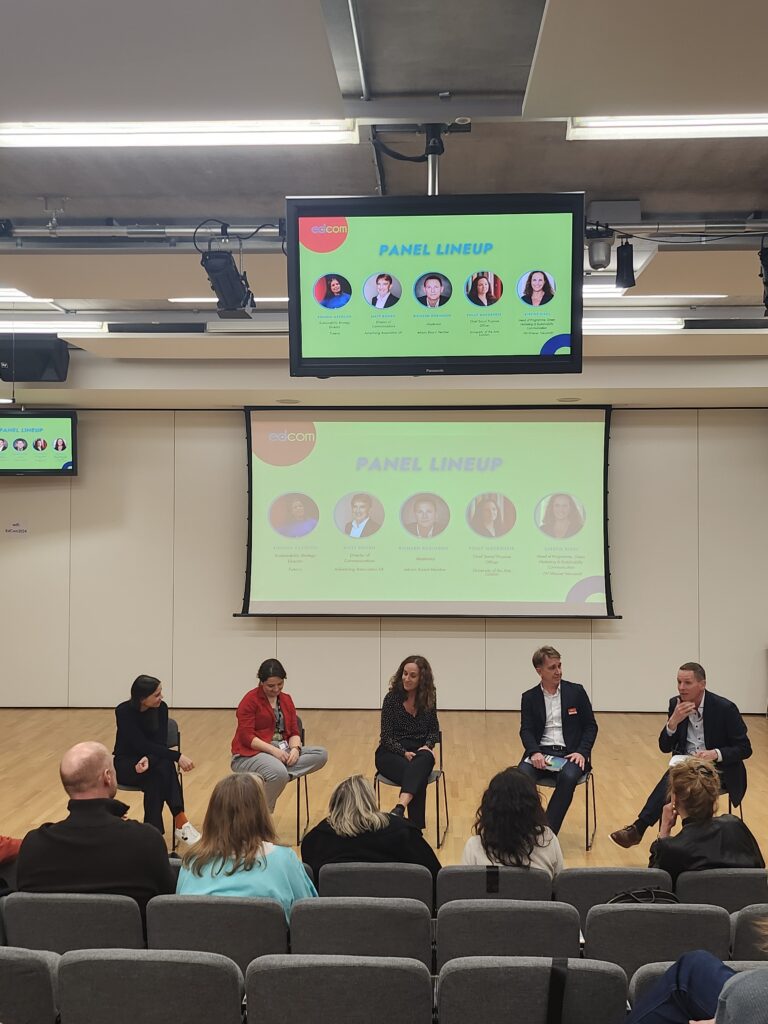
In the Spotlight: How communication can help us shape the future we want to see
Simona Azzolini, Sustainability Strategy Director at Futerra joined the edcom conference in the afternoon to discuss ‘How communication can help us shape the future we want to see’. She discussed brands and companies in terms of the task they have, how they must frame what they are selling or communicating and the solutions or storytelling approaches that have worked for some brands. She highlighted that our choice is to ‘start regenerating’ (stable climate, less pollution, clean air, living income etc.) or ‘keep degenerating’ (more plastic pollution, water shortages, poverty ect.). Consumers and brands are trying to find a balance. Over the past five years, there has been a 71% rise in online searches for sustainable goods globally, according to The Economist Intelligence Unit. Consumers are engaging with sustainable businesses in ways that they previously ignored. According to a survey from McKinsey & Co., 66% of all respondents and 75% of millennial respondents say that they consider sustainability when they make a purchase.
She went on to discuss the need to inspire belief and audiences we need to reach by framing for the hearts and minds. In a report carried out by Futerra highlighted that 55% of consumers think being more sustainable will improve their quality of life while almost four-in-five would like brands to help them become more sustainable. We are not just facing a climate crisis but also a culture crisis with 56% of young people feeling that the world is doomed. Simona stated that we need a plot twist. She suggested reading ‘the Solutionist’ written by Futerra’s founder Solitaire and also another great book ‘What We Think About When We Try Not To Think About Global Warming’ by psychologist and economist Per Espen Stoknes. He identifies the five main psychological barriers to climate action (Distance, Doom, Dissonance, Denial and Identity), and addresses them with five strategies for how to talk about global warming in a way that creates action and solutions, not further inaction and despair. When communicating about the climate, we are talking to three groups of people: Brick Settlers, Green Pioneers and Cold Prospectors. Most people are a mix of these three.
Simona used some great examples of how brands have used these insights about their consumers to effectively communicate their product/brands. Examples of such were; Nest, Oatly, Ganni, Seventh Generation, Ikea, Stanley.
To conclude, Simona stated that we need more brands and companies creating better, more sustainable products and better stories and communication on climate.
Are you curious to know more? Here, you can access the entire presentation.
Here are the videos Simona shared in her presentation:
In the Spotlight: Panel Discussion – Sustainability and Social Purpose
Following Simona’s presentation, we had an insightful panel discussion on Social Purpose and Sustainability with Polly Mackenzie, Chief Social Purpose Officer at UAL, Matt Bourn, Director of Communications at Advertising Association UK and Kirstie Riedl, Head of Green Marketing and Sustainability Communication at FH Wiener Neustadt, moderated by edcom board member Richard Robinson.
To open the discussion, Richard asked our panellists whether there is ever a time when greenwashing is okay. Our panellists discussed how important it is to clean the market of greenwashing and to call out green-hushing. In the 2020 EU survey, more than 50% of green claims were not substantiated. Polly stated that the risk sometimes with climate justice is that achieving everything in one leap is impossible. Justice is absolutely the destination, but sometimes progress is also worth celebrating when it can be backed up. Matt highlighted that there is a lack of work on sustainable case studies, and when setting up best practice awards from one year to the next, the case study often becomes no longer up to standard as practices, criteria, and legislation may have changed.
On the topic of Education, the panel discussed when the academic aspect of sustainability and social purpose should begin being taught. The panel believe there is not enough critical thinking being taught, there needs to be more exposure to these topics earlier as often it’s children that are educating their families. If children are supplied with education, it can mobilise them to change their communities. This needs to be a fundamental change.
The panel also delved into various aspects of branded content and sustainability, particularly focusing on digital platforms and the carbon footprint. Matt highlighted the Ecograder website as a tool to assess sustainability. Concerns were raised about the inability to opt out of targeted advertisements and the need to empower individuals to shape their identities without being subjected to predatory practices.
AI was discussed as a tool, with the ASA adopting it to target sensitive areas and combat predatory behaviour. Questions arose regarding the activism of brands like Ben & Jerry’s and whether it truly aligns with their credibility. Tony’s Chocolonely was praised as a better example due to its independence and authenticity.
Issues of greenwashing were addressed, particularly in advertisements promoting environmental responsibility. The discussion expanded to encompass fast fashion and its various disguises, necessitating policies like producer responsibility and stricter returns policies to combat overconsumption.
Initiatives such as Media Smart were highlighted for educating youth on advertising and sustainability, emphasizing the importance of early engagement. The disconnect between Gen Z and fashion consumption was noted, with suggestions including creating new products and utilising case studies to promote behavioural change. Looking ahead, there is a call for systemic approaches to sustainability and more holistic, multidisciplinary programs.
In the next 12 months, our panel hopes for increased government action on climate change, greater focus on the intersectionality of environmental and social issues and improved public understanding of sustainable consumption.
Following up after the panel discussion, Matt Bourn shared some useful resources and websites that were mentioned during the panel discussion. You can find these here.
26 April – Day 2
After an intense first day of insightful discussions, we kicked off the second day with Gilles Nakhle’s Farewell address.
Gilles conveyed his heartfelt appreciation for edcom’s unwavering support and commitment throughout his presidency. He will continue to contribute to edcom in any way he can as a member. He extended his sincere well wishes to Kirstie and Arnoud as they embark on their presidency journey.
The Ad Venture Student Competition Grand Finale. The three finalist teams, Team the 04 from Sub de Pub, Paris, Team Moonrisers and Team Sunrays from the New Bulgarian University, pitched live to Lipton and the jury of industry and academics to scoop first place and attend the Cannes Lions International Festival of Creativity. Ultimately, the Team The 04 from Sub de Pub, Paris, emerged as winners, taking home the first prize. They will be heading to Cannes in three weeks and have also been kindly granted access to the Dentsu lounge, thanks to Jo Booth.
Are you curious about the top three finalist’s pitches? Here, we gathered all the finalists’ presentations.

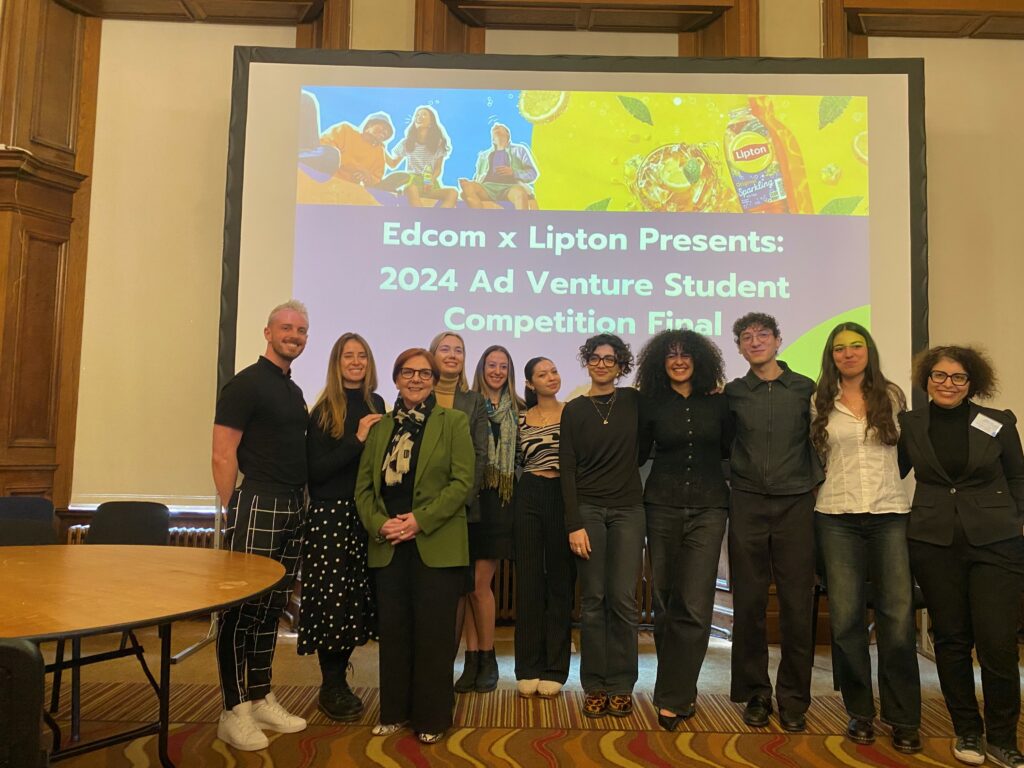
After the final pitch, we had time for more edcom members to showcase their projects and share best practices with other members.
Petr Kral, Prague University of Economics and Business was the first to present on a BIP project in collaboration with two other edcom members; Fontys University, the Netherlands (with Joep Peeters) and Universidad Cardenal Herrera, from Spain (with Manuel Millán). The idea for this collaborative project started in December 2023 at the last edcom meeting. The project which was an AI Campaign Hackathon brought together 30 students from 4 schools. With the support of ZUID Creatives, the students learned how to use AI to solve real problems for real client and created amazing campaigns for KLM Royal Dutch Airlines which they presented to the client.
Find the full presentation here to learn more about this great edcom collaboration.
Next Dr. Leyla Tavernaro-Haidarian - University of Applied Sciences for Management & Communication, Vienna presented on a Student Mobility: Obstacles and Opportunities. They conducted a survey across BA DIB and MA COM/MARS about possible obstacles to student mobility, and they found that the main obstacles were: work obligations, private obligations, financial concerns and lack of information. The University now wants a different type of mobility opportunity for students with a short-term mobility format, greater flexibility and uncomplicated. Dr Leyla Tavernaro-Haidarian would like to talk to any edcom members who are interested in collaborating on these types of mobility opportunities. Find the full presentation here.
Andrea van Zuuk, Utrecht University, The Netherlands, gave the day’s final presentation with a DEMS project update.
The DEMS project is a cooperation between four higher education institutions: Gdańsk University of Technology in Poland, Turku University of Applied Sciences in Finland, and Instituto Politecnico do Porto in Portugal) and is co-funded by the European Union. The project is aimed to achieve the following objectives:
Three Objectives
- Transversal Digital marketing curricula
- Digitalization of Business Teachers
- Digital Skills Challenge for Students
More info on the project can be found at: www.dems.pro . To view the presentation please find it here.
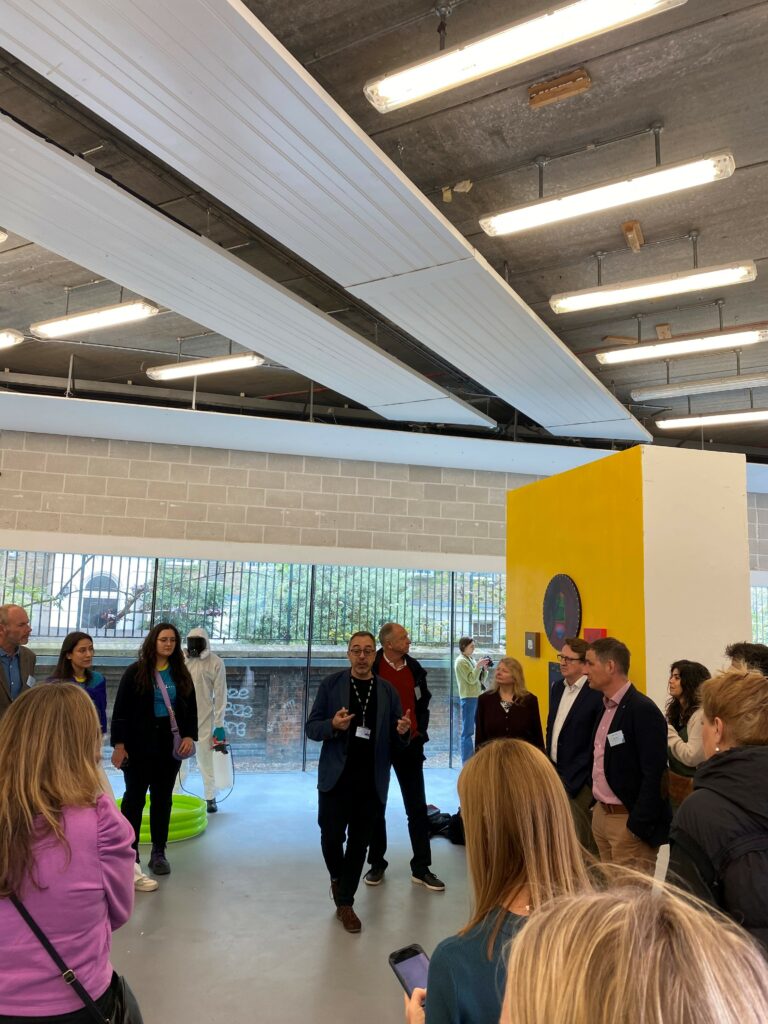
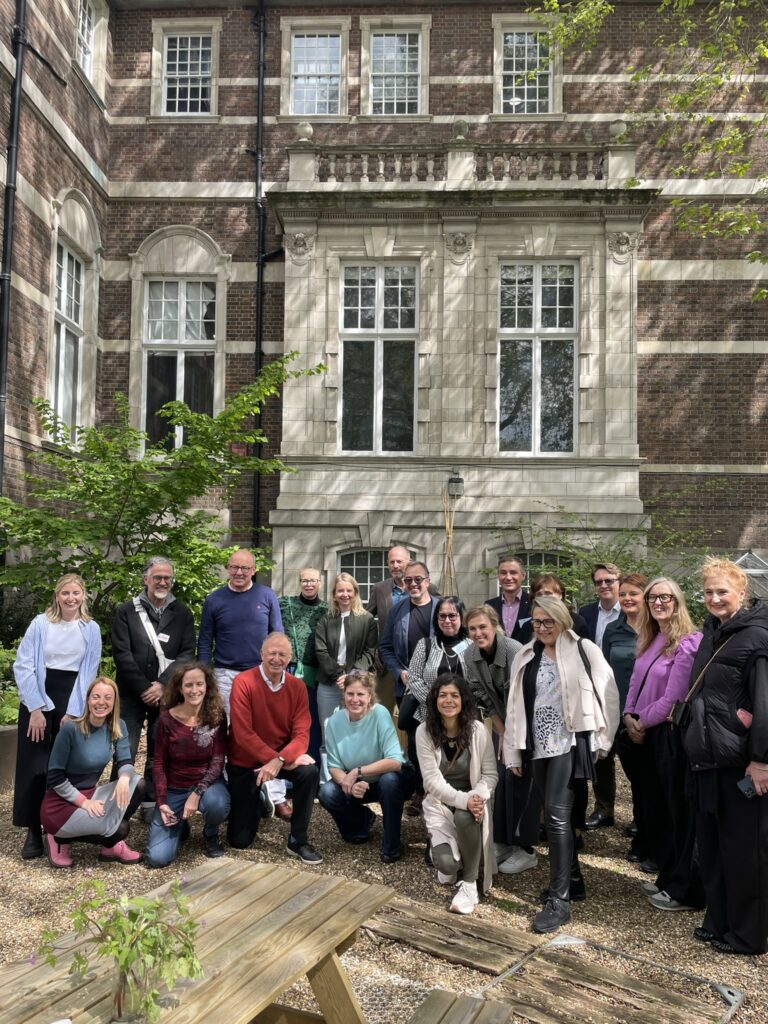
On behalf of edcom we would like to thank everyone who attended the meeting in London, bringing your enthusiasm and bright ideas for the future of edcom helped make this conference a great success. A special thank you to Paul Springer and Heather Malone for their organisation and assistance in hosting us at the University of the Arts London and showing us around their impressive campuses. We are looking forward to this next era for edcom and hope to see you at our next meeting.

